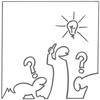Learning Objective(s)
- The purpose of the activity is for all participants to get a chance to reflect on the importance and difficulty of co-operation when trying to solve a difficult task together. Especially when you have different perspectives and interest in how the task is to be solved.
- Activities without much explanation will put people to the test and they will need to communicate and use their resilience in order to not give up.
Instructions
Step 1 – Group the participants into 5-7 people in each group, place them at a table together.
Step 2 – Instruct the groups that they are competing in solving the task as fast as possible.
Step 3 – Instruct the groups that they have 40 minutes max to solve the task.
Step 4 – They cannot leave the table during the 40 minutes.
The leader is the observer and will observe what goes on in the groups. (Do not inform the participants about this!)
Observe: Who takes charge? Who finds this boring? Who finds it fun? Who participates? Who is uninterested? How do the different participants show their perspective of solving the task?
Step 5 – If there are more than 2 tables, it is advisable that there are 2 observers.
Step 6 – If one or more tables finishes before the 40 minutes are up, they may take a break and return when the 40 minutes are up.
Step 7 – Reunion. The leader asks how the participants experienced the activity and ask if they saw what happened in their group.
Step 8 – The leader/observer can now share their observations and invite the participants into a discussion.
- Can the participants relate to the observations that were made?
- What decides how we take on different roles in situations like this?
- What was the most important lesson from this activity, according to the group?
- What can be learnt from this activity?
What usually happens is that some participants seem to be the leader but after a while someone else takes over. Someone might be very enthusiastic in the beginning but might give up after a while. Some may appear passive but in reality they are laying low and working in silence. Some want to rule and this might lead to conflicts. Some want to complete the task with others, while some want to sit by themselves, etc.
Reflection/self-assessment
General discussion connected to real world experiences:
- How are we affected by our different ways of reacting to the same task and how does this matter in our every day lives?
Instructions
Step 1 – Group the participants into 5-7 people in each group, place them at a table together.
Step 2 – Instruct the groups that they are competing in solving the task as fast as possible.
Step 3 – Instruct the groups that they have 40 minutes max to solve the task.
Step 4 – They cannot leave the table during the 40 minutes.
The leader is the observer and will observe what goes on in the groups. (Do not inform the participants about this!)
Observe: Who takes charge? Who finds this boring? Who finds it fun? Who participates? Who is uninterested? How do the different participants show their perspective of solving the task?
Step 5 – If there are more than 2 tables, it is advisable that there are 2 observers.
Step 6 – If one or more tables finishes before the 40 minutes are up, they may take a break and return when the 40 minutes are up.
Step 7 – Reunion. The leader asks how the participants experienced the activity and ask if they saw what happened in their group.
Step 8 – The leader/observer can now share their observations and invite the participants into a discussion.
- Can the participants relate to the observations that were made?
- What decides how we take on different roles in situations like this?
- What was the most important lesson from this activity, according to the group?
- What can be learnt from this activity?
What usually happens is that some participants seem to be the leader but after a while someone else takes over. Someone might be very enthusiastic in the beginning but might give up after a while. Some may appear passive but in reality they are laying low and working in silence. Some want to rule and this might lead to conflicts. Some want to complete the task with others, while some want to sit by themselves, etc.
Reflection/self-assessment
General discussion connected to real world experiences:
- How are we affected by our different ways of reacting to the same task and how does this matter in our every day lives?
Assessment Methods
- Observation
- Group discussion after activity
Resources needed
- Copies of “Who owns the zebra” activity
- Answer key


 50 Minutes
50 Minutes










